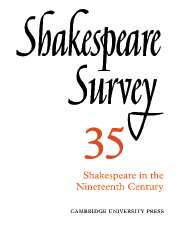Book contents
- Frontmatter
- Before the Shakespeare Revolution: Developments in the Study of Nineteenth-Century Shakespearian Production
- The Meininger Company and English Shakespeare
- Shakespeare at the Burgtheater: From Heinrich Anschütz to Josef Kainz
- Shakespeare on the Melbourne Stage, 1843-61
- Shakespeare in Hazlitt’s Theatre Criticism
- Characterization of the Four Young Lovers in A Midsummer Night’s Dream
- Queenly Shadows: On Mediation in Two Comedies
- Language, Theme, and Character in Twelfth Night
- The Art of the Comic Duologue in Three Plays by Shakespeare
- ‘Spanish’ Othello: The Making of Shakespeare’s Moor
- Ferdinand and Miranda at Chess
- Shakespeare’s Latin Citations: The Editorial Problem
- The Theatre at Christ Church, Oxford, in 1605
- Interpretations of Shakespearian Comedy, 1981
- The Year's Contributions to Shakespearian Study 1 Critical Studies
- 2 Shakespeare’s Life, Times and Stage
- 3 Textual Studies
- Index
- Plate Section
‘Spanish’ Othello: The Making of Shakespeare’s Moor
Published online by Cambridge University Press: 28 March 2007
- Frontmatter
- Before the Shakespeare Revolution: Developments in the Study of Nineteenth-Century Shakespearian Production
- The Meininger Company and English Shakespeare
- Shakespeare at the Burgtheater: From Heinrich Anschütz to Josef Kainz
- Shakespeare on the Melbourne Stage, 1843-61
- Shakespeare in Hazlitt’s Theatre Criticism
- Characterization of the Four Young Lovers in A Midsummer Night’s Dream
- Queenly Shadows: On Mediation in Two Comedies
- Language, Theme, and Character in Twelfth Night
- The Art of the Comic Duologue in Three Plays by Shakespeare
- ‘Spanish’ Othello: The Making of Shakespeare’s Moor
- Ferdinand and Miranda at Chess
- Shakespeare’s Latin Citations: The Editorial Problem
- The Theatre at Christ Church, Oxford, in 1605
- Interpretations of Shakespearian Comedy, 1981
- The Year's Contributions to Shakespearian Study 1 Critical Studies
- 2 Shakespeare’s Life, Times and Stage
- 3 Textual Studies
- Index
- Plate Section
Summary
Many studies of Othello confront as a vital problem what they see as some inherent randomness in the play. The current agreement, too, that the work is a ‘domestic tragedy’ may more tacitly voice the same reaction, depending as it seems to do on Bradley’s sense of the play as less great than the others of the Big Four, because the dramatist had not fully succeeded in universalizing his materials – a judgement that brings us back to that ‘randomness’ again. This widespread reaction among readers and critics is not my subject here; I want to use it only to suggest that if that randomness really does survive in Othello as an achieved work of art, then it surely originates from the play’s main source, Cinthio’s prose narrative. It is hard for a reader of Shakespeare not to define literary merit as quantity of meaning – even in a case like Othello where the ‘meaning’ in a higher sense is still distinctly moot; the play, despite all the doubt, means a good deal to us. Of merit or meaning in that sense Cinthio’s story has little. Given what we cannot help finding the mere externality of its avowed moral, its only meaning lies in the purposiveness of the Ensign’s love-jealousy; when Shakespeare removes or blurs this he leaves what remains of the narrative as a succession of events that are’ cruel’, almost in the modern sense of ‘absurd’.
- Type
- Chapter
- Information
- Shakespeare Survey , pp. 101 - 112Publisher: Cambridge University PressPrint publication year: 1982
- 3
- Cited by

